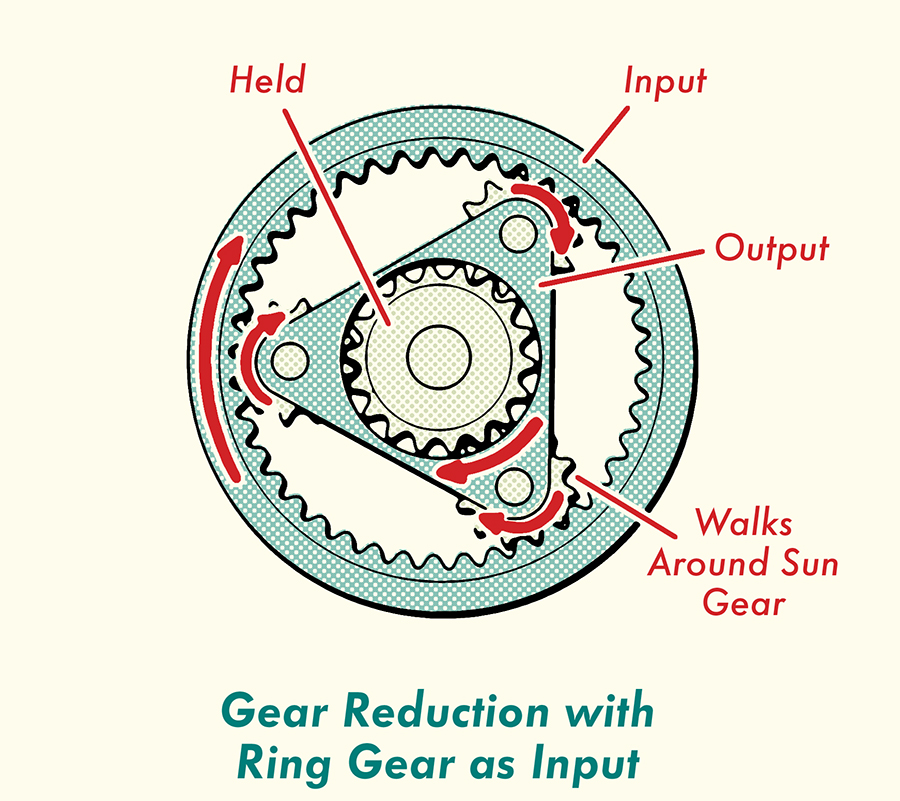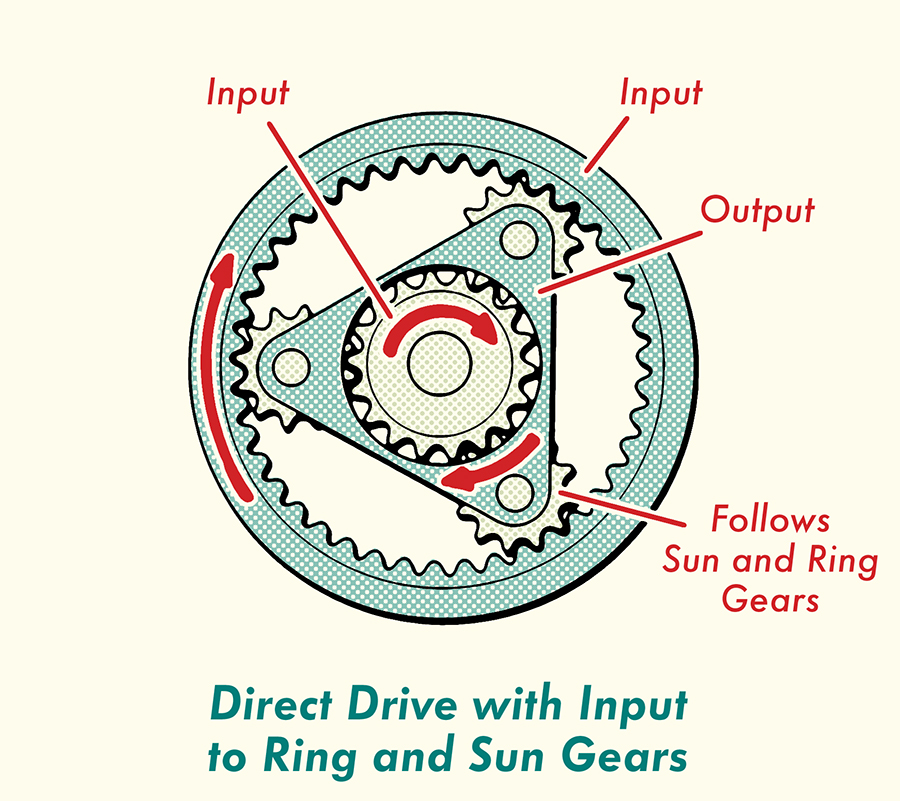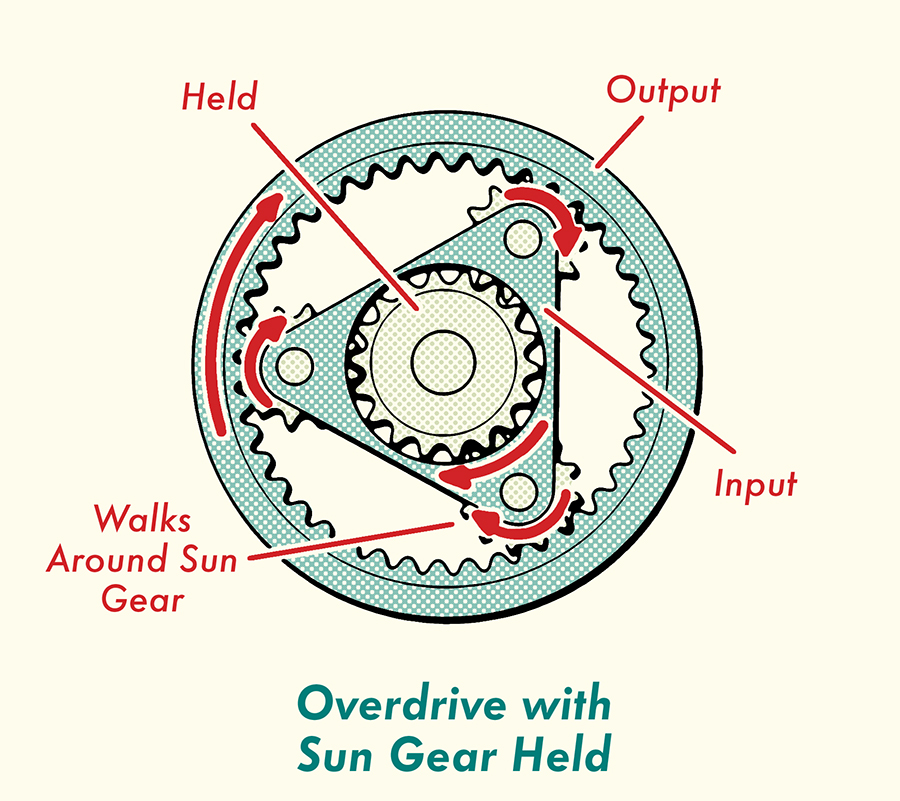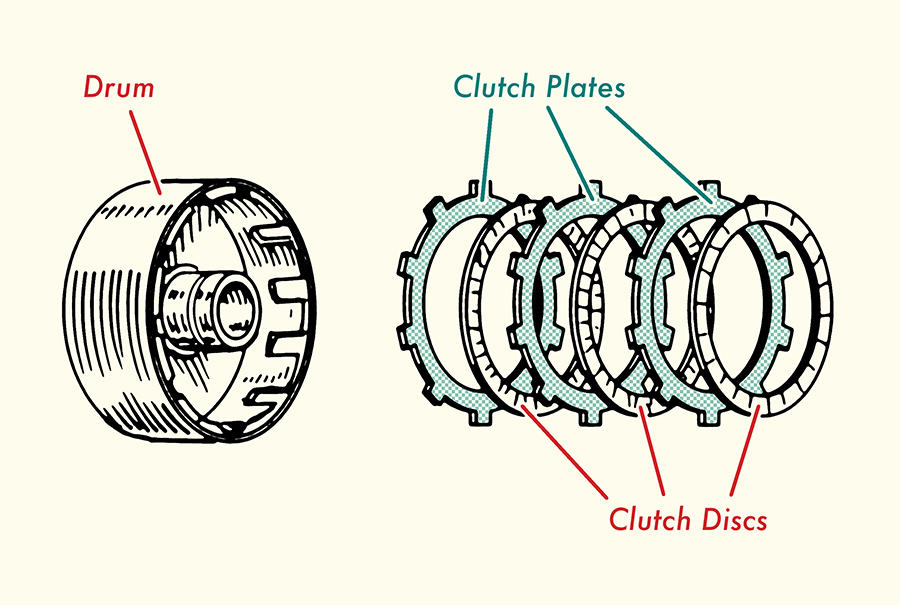
As your vehicle reaches higher speeds, it needs less torque to keep the car going. Transmissions can increase or decrease the amount of torque sent to the car’s wheels thanks to gear ratios. The lower a gear ratio is, the more torque is delivered. The higher a gear ratio is, the less torque is delivered.
On a manual transmission, you have to move your gear shift to change the gear ratios.
On an automatic transmission, gear ratios increase and decrease automatically. And this is able to happen thanks to the ingenious design of a planetary gear.
A planetary gear consists of three components:
- A sun gear. Sits at the center of the planetary gear set.
- The planet gears/pinions and their carrier. Three or four smaller gears that surround the sun gear and are in constant mesh with the sun gear. The planet gears (or pinions) are mounted and supported by the carrier. Each one of the planet gears spins on their own separate shafts that are connected to the carrier. Planet gears not only spin, but they also orbit the sun gear.
- The ring gear. The ring gear is the outer gear and has internal teeth. The ring gear surrounds the rest of the gear set, and its teeth are in constant mesh with the planet gears.
A single planetary gear set can achieve reverse drive and five levels of forward drive. It all depends on which of the three components of the gear set is moving or held stationary.
Let’s take a look at that in action with the different components acting as either the input gear (the gear that is generating the power), the output gear (the gear that receives power), or being held stationary.
Sun Gear: input gear / Planetary Carrier: output gear / Ring Gear: held stationary

In this scenario, the sun gear is the input gear. The ring gear doesn’t move. With the sun gear moving, and the ring gear held in place, the planetary gears will rotate on their own carrier shafts and walk around the inside of the ring gear, but in the opposite direction as the sun gear. This causes the carrier to rotate in the same direction as the sun gear. The carrier thus becomes the output gear.
This configuration creates a low gear ratio which means the input gear (in this case, the sun gear) spins faster than the output gear (the planet carrier). But the amount of torque the planet carrier creates is much more than the sun gear delivers.
This sort of configuration would be used when the car is just getting started.
Sun Gear: held stationary / Planetary Carrier: output gear / Ring Gear: input gear

In this scenario, the sun gear is held stationary, but the ring gear becomes the input gear (that is, it’s delivering power to the gear system). Because the sun gear is being held, the spinning planet gears will walk around the sun gear and carry the planet carrier with them.
The planet carrier moves in the same direction as the ring gear and is an output gear.
This configuration creates a bit higher gear ratio than the first configuration. But the input gear (the ring gear) is still spinning faster than the output gear (the planetary carrier). This results in the planetary gear delivering more torque, or power, to the rest of the drivetrain. This configuration would likely be in play as your car speeds up from a dead stop, or when you’re driving up a hill.

In this scenario, both the sun gear and ring gear act as input gears. That is, both are spinning at the same speed and in the same direction. This causes the planetary gears to not spin on their individual shafts. Why? If the ring gear and the sun gear are the input members, the internal teeth of the ring gear will try to rotate the planetary gears in one direction, while the external teeth of the sun gear will try to drive them in the opposite direction. So they lock into place. The whole unit (sun gear, planetary carrier, ring gear) moves together at the same speed and they transfer the same amount of power. When the input and the output transfer the same amount of torque, it’s called direct drive.
This arrangement would be in play when you’re cruising around 45-50 mph.

In this scenario, the sun gear is held stationary, and the planetary carrier becomes the input gear that delivers power to the gear system. The ring gear is now the output gear.
As the planet carrier rotates, the planetary gears are forced to walk around the held sun gear, which drives the ring gear faster. One complete rotation of the planet carrier causes the ring gear to rotate more than one complete revolution in the same direction. This is a high gear ratio and provides more output speed but less torque. This arrangement is also known as “overdrive.”
You’d be in this configuration when you’re driving on the freeway at 60+ mph.
An automatic transmission usually has more than one planetary gear set. They work together to create multiple gear ratios.
Because the gears are in constant mesh in a planetary gear system, gear changes are made without engaging or disengaging gears, like you do on a manual transmission.
But how does an automatic transmission tell which parts of the planetary gear system should act as the input gear, the output gear, or be held stationary, so we can get those varying gear ratios?
With the help of brake bands and clutches inside the transmission.
Brake Bands and Clutches
Brake bands are made of metal lined with organic friction material. The brake bands can tighten to hold the ring or sun gear stationary or loosen to let them spin. Whether a brake band tightens or loosens is controlled by a hydraulic system.

A series of clutches also connect to the different parts of a planetary gear system. Transmission clutches in automatic transmissions are made up of multiple metal and friction discs (which is why they’re sometimes referred to as a “multi disc clutch assembly”). When the discs are pressed together, it causes the clutch to engage. A clutch can cause a planetary gear part to become an input gear or it could cause it to become stationary. It just depends on how it’s connected to the planetary gear. Whether a clutch engages or not is driven by a combination of mechanical, hydraulic, and electrical design. And it all happens automatically.
Comments
Post a Comment